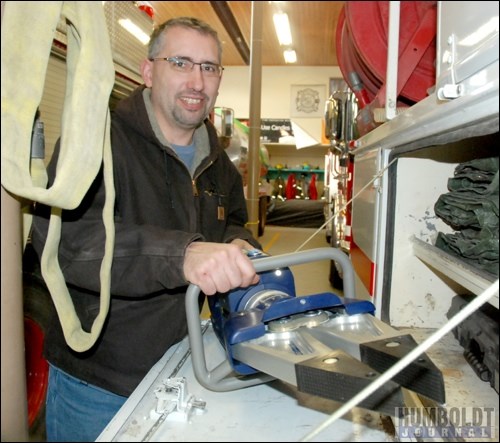They're in and ready to save lives.
The Humboldt Fire Department's new set of Jaws of Life arrived at the fire hall in early February. The series of tools are now safely installed in the rescue unit, ready to roll when called into action to cut people out of vehicles after a collision.
Humboldt's Fire Chief Mike Kwasnica started explaining the advantages of the new set by describing the old set, which is now housed on one of their other trucks, still ready to be called into use if necessary.
The old set, Kwasnica said, opening up their storage space on the truck, is powered by a gas-powered hydraulic pump. A 10-foot-long hydraulic hose connected that pump to the tools - the spreader, the cutter, and two rams - but only one at a time.
"We were limited to (using) one tool at a time," said Kwasnica, "and to an area 10 feet away from the pump."
That's a complication when trying to extricate multiple people from vehicles as quickly as possible.
The motor was also very noisy, Kwasnica said. That meant a lot of shouting between firefighters when the tools were in use.
This was the conventional system for the Jaws of Life for a long time.
However, technology has now advanced and the new set is cordless.
Kwasnica hauled the new spreader tool out of the rescue unit for explanation and demonstration.
The new spreaders are slightly heavier than the conventional set, Kwasnica noted - they require no less than a two-handed grip. Part of that is because each tool has a hydraulic pump built in.
There's no gas-powered pump to start to operate one of these new tools. Stick a battery in the bottom of one, press a button and you're ready to go.
The tools are still hydraulically driven, Kwasnica insisted, but the battery runs the pump built into each separate tool.
Each battery - which resembles those for a regular drill, only larger - holds 20 minutes of actual operating time. When sitting idle, they lose just two per cent of their power per month.
"They hold the power very well," said Kwasnica.
The batteries themselves are designed in Europe, he noted, and are pretty perfect for what they need. They don't hold a memory, and can be recharged at any stage. They will work in -40C and are supposed to work underwater.
The new tools have LED headlights, Kwasnica pointed out as he powered up the spreader for a moment, which can help firefighters see what they're doing without trying to point another flashlight at the area.
The new tools are also very, very quiet when they're operating, as opposed to the old Jaws, which worked with the sound of the pump in the background.
"And they are very, very versatile," Kwasnica said. "We can run three at once if we need to."
And if all of the batteries run down and they still need to get someone out of a car, they have a 110 adapter, Kwasnica said, that will run the tools off a generator.
The entire set of new Jaws and batteries - that's the spreader, cutter, ram, and seven batteries - cost about $30,000.
A huge chunk - $23,000 - was donated by PotashCorp. That covered the spreader and the cutter.
The other $7,000 came from the Firefighters' Equipment Fund, with help from local RMs and the Humboldt Co-op.
"That bought the extra batteries and the rams," Kwasnica said.
Some of the funds raised for the Jaws came from the sale of 2013 calendars, made through a partnership between the Humboldt Fire Department and the Humboldt Journal.
With the new set of Jaws, the old set will be kept as backup, just in case they have a situation where two sets are needed at the same time.
"It was time to upgrade," Kwasnica said of why they wanted to get new Jaws.
They had the new type out at a practice last year, he said, and the firefighters decided that this was the way to go.
"It's become the most popular tool in the province," Kwasnica said of the cordless Jaws.
The Humboldt Fire Department is called in often to extricate people from vehicles.
They respond to most of the vehicle collisions with injuries in the area, and perform extrications about six times a year.
They have had to extricate people from two different vehicles quite a distance apart twice in the last five years, Kwasnica reported.
Luckily, they had another backup set of Jaws then.
"Now we have two really good sets of Jaws," Kwasnica said.
The older Jaws, once the backups, have been bumped down the list, to be called into use in cases where the other two are already in use. They will be kept in one of the City's trucks.




